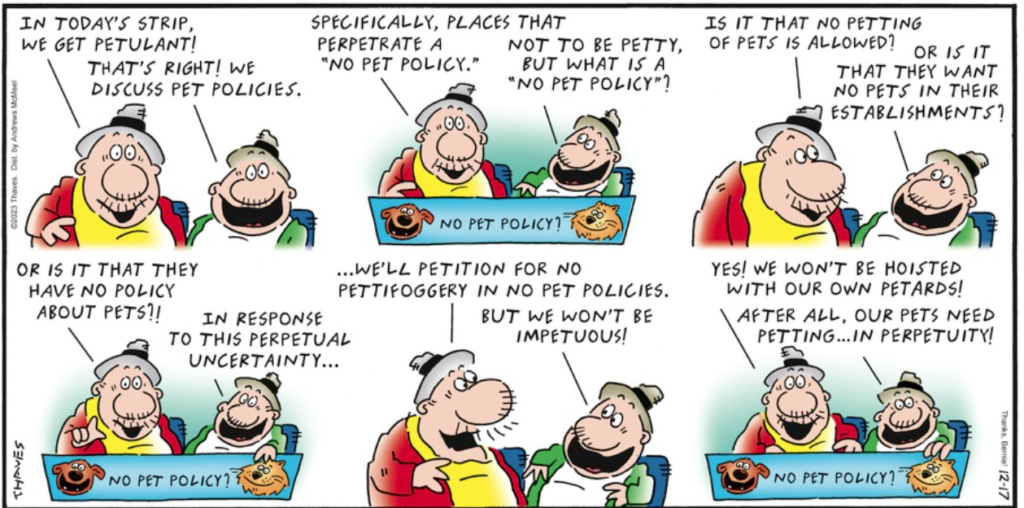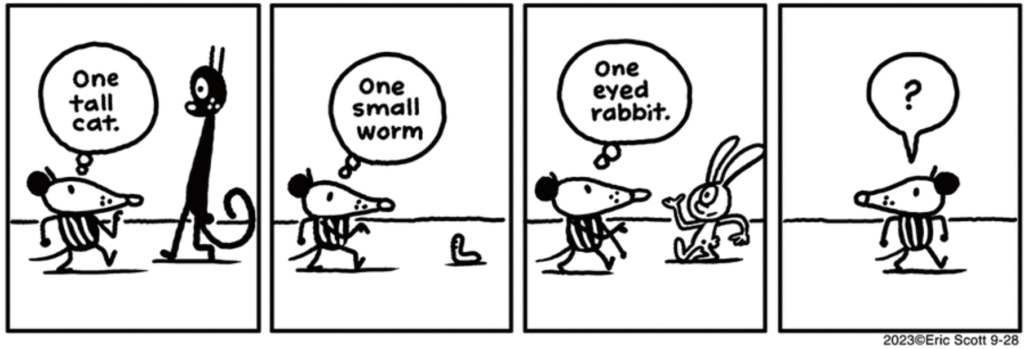A Good Example of why Hyphens are Important
One function of hyphens is to tie two words together into what we call a compound adjective. The difference in which word (or words) another word modifies can be significant. Lots of humor in this strip, but read the label on the sign.
Now look at the first panel in the bottom row. He reads the sign correctly! Without the hyphen, “no” modifies “pet policy.” If you have a policy that forbids pets, you have to say “no-pet policy.”
PS—I just ran into this. Same lesson, only about the space between words. I found it on Facebook

Subscribe to this blog's RSS feed
Another Hyphen Lesson
In english, adjectives normally belong right before the word they modify, but sometimes we put two words together to make a compound adjective. Then we need to hyphenate!
See? In the first two, each adjective separately modifies the last word. In the third panel, though, we have a compound adjective, so it should have a hyphen. Except then the comic wouldn’t be as funny.
Fancy Compound Adjectives
Two of them in the same sentence! Plus a normal compound adjective
The first-of-its-kind habitat is teeming with never-before-seen life-forms, including strange species of worms, snails and deep-dwelling octopuses.
https://www.livescience.com/animals/hidden-underworld-filled-with-never-before-seen-creatures-discovered-beneath-the-seafloor
I don’t recommend getting rid of compound adjectives, even fancy ones. They speed up the sentence. Just be sure to hyphenate as necessary.
A less smooth rewrite:
A habitat that humans have just begun to explore (under the floor of the ocean) teems with creatures that we have never seen before. These include worms, snails, and deep-dwelling octopuses.
See? fancy compound adjectives can be good!
Here’s a picture of one of the creatures:

Compound Noun, Compound Adjective
Hyphenated compound nouns are fairly uncommon, but here’s an example, with a compound adjective after it. It’s a recent (February 10, 2023) Washington Post headline.
Biden ordered [a/the] shoot-down of a ‘high-altitude object’ over Alaska airspace
Headlines tend to be terse, so I added the articles in the brackets to make it easier to see that they combined a verb and a preposition to make a “shoot-down” into a noun. In English, compound nouns tend to migrate from being hyphenated (such as “pick-up”) to being a single word (pickup) as they become more common. We don’t say “a shoot-down” very often.
You can easily tell that “high-altitude” is an adjective because it refers to “object.”
Sorry, no picture of the object yet. [later] Okay, here’s a photo. The balloon is the white circular object.

Hyphenate Those Compound Adjectives!
Here’s a good example that shows the difference between hyphenated and unhyphenated adjectives. Here’s the a headline:
Axios AM: Fake burger crash
https://www.axios.com/newsletters/axios-am-02b0d9c0-ca6c-4ae0-b862-a72a69f97955.html
So what’s fake? The burger (fake burger) or the crash? (fake crash)
Turns out when you look at the article that has this headline, it’s fake burgers that crash for real.
You need the hyphen to tie “fake” and “burger” together! It’s “fake-burger crash.”
Here’s the picture that goes with the article:



